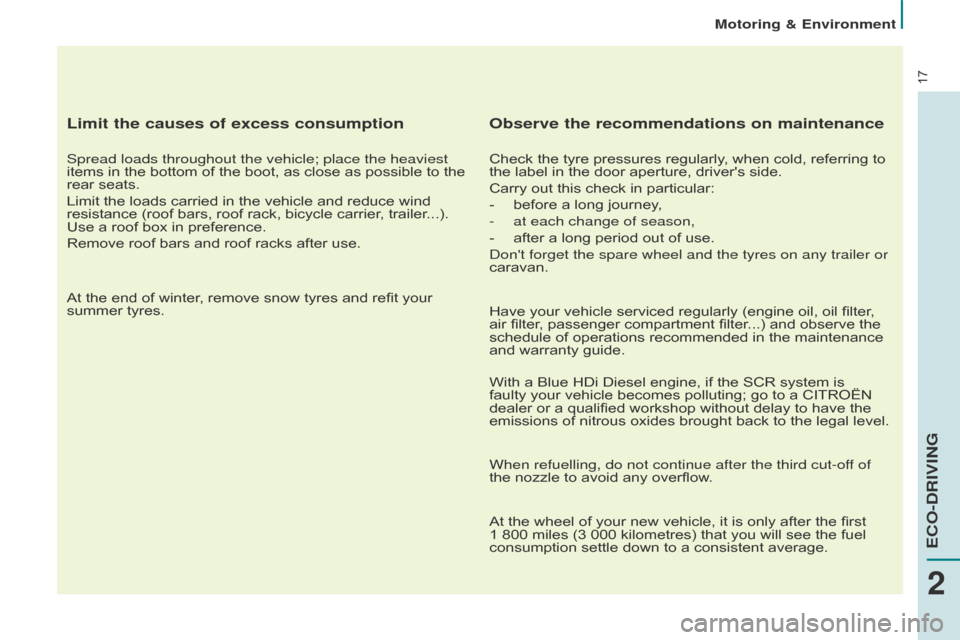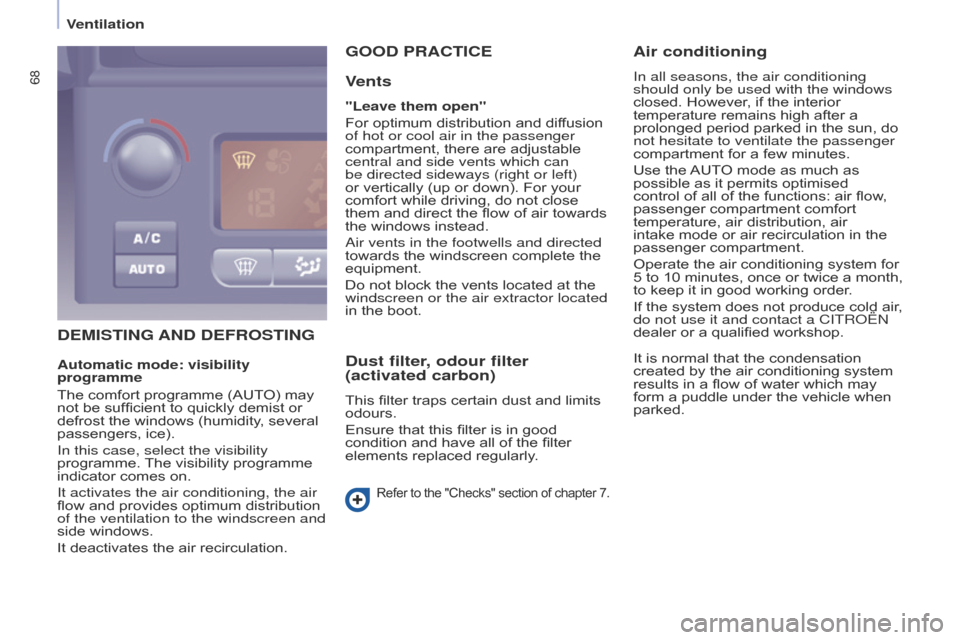boot Citroen BERLINGO MULTISPACE RHD 2015 2.G Owner's Manual
[x] Cancel search | Manufacturer: CITROEN, Model Year: 2015, Model line: BERLINGO MULTISPACE RHD, Model: Citroen BERLINGO MULTISPACE RHD 2015 2.GPages: 276, PDF Size: 12.21 MB
Page 19 of 276

17
Limit the causes of excess consumption
Spread loads throughout the vehicle; place the heaviest
items in the bottom of the boot, as close as possible to the
rear
seats.
Limit
the loads carried in the vehicle and reduce wind
resistance
(roof bars, roof rack, bicycle carrier, trailer...).
Use
a roof box in preference.
Remove
roof bars and roof racks after use.
At
the end of winter, remove snow tyres and refit your
summer
tyres.
Observe the recommendations on maintenance
Check the tyre pressures regularly, when cold, referring to the label in the door aperture, driver's side.
Carry
out this check in particular:
-
before
a long journey,
-
at each change of season,
-
after
a long period out of use.
d
on't forget the spare wheel and the tyres on any trailer or
caravan.
Have
your vehicle serviced regularly (engine oil, oil filter,
air
filter, passenger compartment filter...) and observe the
schedule
of operations recommended in the maintenance
and
warranty guide.
With
a Blue HDi Diesel engine, if the SCR system is
faulty
your vehicle becomes polluting; go to a CITROËN
dealer
or a qualified workshop without delay to have the
emissions
of nitrous oxides brought back to the legal level.
When refuelling, do not continue after the third cut-off of
the
nozzle to avoid any overflow.
At
the wheel of your new vehicle, it is only after the first
1
800 miles (3 000 kilometres) that you will see the fuel
consumption
settle down to a consistent average.
2
EcO-drIVInG
Motoring & Environment
Page 70 of 276

Berlingo_2_VP_en_Chap04_Ergonomie_ed02-2014
68
dEMIStInG And dEF r OS t I n GGOO d P r A ct I c E
Vents
"Leave them open"
For optimum distribution and diffusion
of hot or cool air in the passenger
compartment,
there are adjustable
central and side vents which can
be directed sideways (right or left)
or
vertically (up or down). For your
comfort
while driving, do not close
them
and direct the flow of air towards
the
windows instead.
a
ir vents in the footwells and directed
towards
the windscreen complete the
equipment.
Do
not block the vents located at the
windscreen or the air extractor located
in
the boot.
dust filter, odour filter
(activated carbon)
This filter traps certain dust and limits odours.
Ensure
that this filter is in good
condition
and have all of the filter
elements
replaced regularly.
Refer to the "Checks" section of chapter 7.
Air conditioning
In all seasons, the air conditioning
should only be used with the windows
closed. However, if the interior
temperature
remains high after a
prolonged
period parked in the sun, do
not hesitate to ventilate the passenger
compartment
for a few minutes.
Use
the
AUT
O mode as much as
possible
as it permits optimised
control
of all of the functions: air flow,
passenger
compartment comfort
temperature,
air distribution, air
intake
mode or air recirculation in the
passenger
compartment.
Operate
the air conditioning system for
5
to
10
minutes,
once
or
twice
a
month,
to
keep it in good working order.
If
the system does not produce cold air,
do not use it and contact a CITR
o Ë n
dealer
or a qualified workshop.
Automatic mode: visibility
programme
The
comfort
programme
(AUTO)
may
not
be
sufficient
to
quickly
demist
or
defrost
the
windows
(humidity,
several
passengers,
ice).
In this case, select the visibility
programme.
The
visibility
programme
indicator
comes
on.
It activates the air conditioning, the air
flow
and
provides
optimum
distribution
of the ventilation to the windscreen and
side
windows.
It
deactivates
the
air
recirculation. It
is normal that the condensation
created
by the air conditioning system
results
in a flow of water which may
form
a puddle under the vehicle when
parked.
Ventilation
Page 93 of 276

Berlingo_2_VP_en_Chap04_Ergonomie_ed02-2014
91
From insideFrom outside
rear box
This roof box can be accessed from the
rear seats and the boot.
From
the rear seats, slide the flaps to
open.
Vents
a 3-position control allows you to
adjust the air flow through the vents.
The
vents are also fitted with a scented
air
freshener.
From
the
boot,
place
your
thumb
on
the recess then pull the handle to
open.
Open
carefully
to
prevent
objects
stored
in
this
interior
roof
box
from
fallin
g
out.
The
maximum
authorised
load
is
10
kg.
Practical information
EASE OF uSE and cOMFOrt
4
Page 99 of 276

Berlingo_2_VP_en_Chap04_Ergonomie_ed02-2014
97
LOAd SPAcE cOVEr (5 SEAt VE r SIO n)
This rigid shelf conceals the objects stored
in the boot.
r
emoving
Fold the load space cover.
Detach it from the notches A and B
pulling
it towards you.
Raise
it and remove the assembly.
Refitting
Place the load space cover in front
of
A and B.
Push it forwards to insert the lugs in
the
notches.
Unfold and clip into the notches
c .
Folding
From
the boot, fold the half-shelf,
raising
it to detach it from the notch c . Storing (according to version)
A
location is provided in the back of the rear
seats to accommodate the load
space
cover folded onto itself.
Slide it vertically between the side
guides
located at mid seat back height.
Insert
the hinge first, with the free flaps
turned
upwards.
This rigid load space cover can
form
a shelf. However, for safety
reasons,
do not place objects
on
it which could become dangerous
projectiles
in the event of sharp braking
or
rear impact.
Practical information
EASE OF uSE and cOMFOrt
4
Page 102 of 276

Berlingo_2_VP_en_Chap04_Ergonomie_ed02-2014
100
Storage flaps
Raise the corresponding flap.next to the boot sill, the recess is
intended to receive the roller tube
containing
the load space cover.
Seat belts
Ensure that the centre seat belt has
reeled in correctly to its strengthener
on the roof.
Prevent
the row 3 seat belt buckles
from
knocking by raising them as close
as possible to the anchorages in the
roof.
The
seat belt buckle attachment rings
on
each side of the boot must not be
used
to retain loads.
Practical information
Page 103 of 276

Berlingo_2_VP_en_Chap04_Ergonomie_ed02-2014
101
LOAd SPAcE ScrEEn, LOAd
SP A c E c OVE r
The load space screen is a load space cover of the
blind type with roller. T ake care not to place heavy objects
on the load space cover when unrolled.
Position the load space screen so as to
present the rear load space cover flaps
towards
you.
Engage the left-hand lug of the roller in
the support A.
to install it
Place the row 3 seats in the fully folded
position.
Raise
the
storage
flap
at
the
boot
sill.
Take
hold
of
the
roller
in
the
centre
and
compress
it
towards
the
left-hand
pillar.
Raise
the
assembly. Compress
then place the right-hand lug facing the support
B.
Release to engage the roller in its
support.
Unroll the load space cover to the rear
side
pillars.
Engage the ends in the rear notches to
keep
it taut.
Practical information
EaSE oF USE and CoMFoRT
4
Page 104 of 276

Berlingo_2_VP_en_Chap04_Ergonomie_ed02-2014
102
to remove it
From the boot, pull the load space
cover
towards you to release it from
the
side pillars.
Guide
the load space cover as it rolls up.
Remove
the clips of the three flaps
from
the base of each row 2 head
restraint.
Compress
the roller to the left to
remove
it from the support B.
Raise
it and pivot it forwards.to store it
Store it in the recess at the boot sill,
with
the two rear flaps uppermost.
First,
compress the load space screen
to
the left.
Release.
Arrange
the two flaps and close the
storage
flap.
The
roller
is
fitted
with
three
flaps
permitting
concealment
of
the
boot, whether the row 2 seats
are
in
the
normal
position
or
the
comfort
position.
Each
flap
has
two
clips
which
are
hooked
on
the
base
of
each
head
restraint.
Practical information
Page 151 of 276

Berlingo_2_VP_en_Chap07_Verification_ed02-2014
149
AdBLuE® AddItIVE
A
nd S
cr
SYS t EM
FO
r B
L
u
E H dI dIESEL
E
n
GI
n
ES
To assure respect for the environment and conformity with the new Euro 6
emissions
standard, without adversely
af
fecting the performance or fuel
consumption
of Diesel engines,
CITROËN
has taken the decision to
equip
its vehicles with an effective
system
that associates SCR (Selective
Catalytic Reduction) with a particle
filter
(FAP) for the treatment of exhaust
gases.
Presentation of the Scr system
Using an additive called adBlue®
containing urea, a catalytic converter
turns up to 85% of nitrous oxides
(
no
x) into nitrogen and water, which
are
harmless
to
health
and
the
environment.
The
a
dBlue
® additive is held in a
special
tank
located under the boot
at
the
rear
of the vehicle. It has a
capacity
of
17 litres: this provides a
driving
range of about 12 500 miles
(20
000 km), after which an alert
is triggered warning you when the
reserve
remaining is enough for just
1
500
miles
(2 400 km).
d
uring each scheduled service of
your vehicle by a CITR
o Ë n dealer
or
a
qualified workshop, the
AdBlue®
additive
tank
is
refilled
in
order
to
allow
normal
operation
of
the
SCR
system.
If
the
estimated
mileage
between
two services is greater than
12 500 miles
(20
000
km),
we
recommend
that
you
go
to
a
CITROËN
dealer
or
a
qualified
workshop
to
have
the
necessary
top-up
carried
out.
o
nce the a dBlue
® tank is empty, a
system
required by regulations
prevents
starting
of the engine.
If the SCR
is faulty, the level of
emissions
from
your
vehicle will no
longer
meet
the
Euro
6 standard: you
vehicle
becomes
polluting.
In
the
event
of
a
confirmed fault
with
the
SCR
system,
you must go
to
a
CITROËN
dealer
or a qualified
workshop
as
soon
as
possible: after
a
running
distance
of
650 miles
(1
100
km),
a
system
will be triggered
automatically
to
prevent engine
starting.
AdBlue® additive
cHEcKS
7